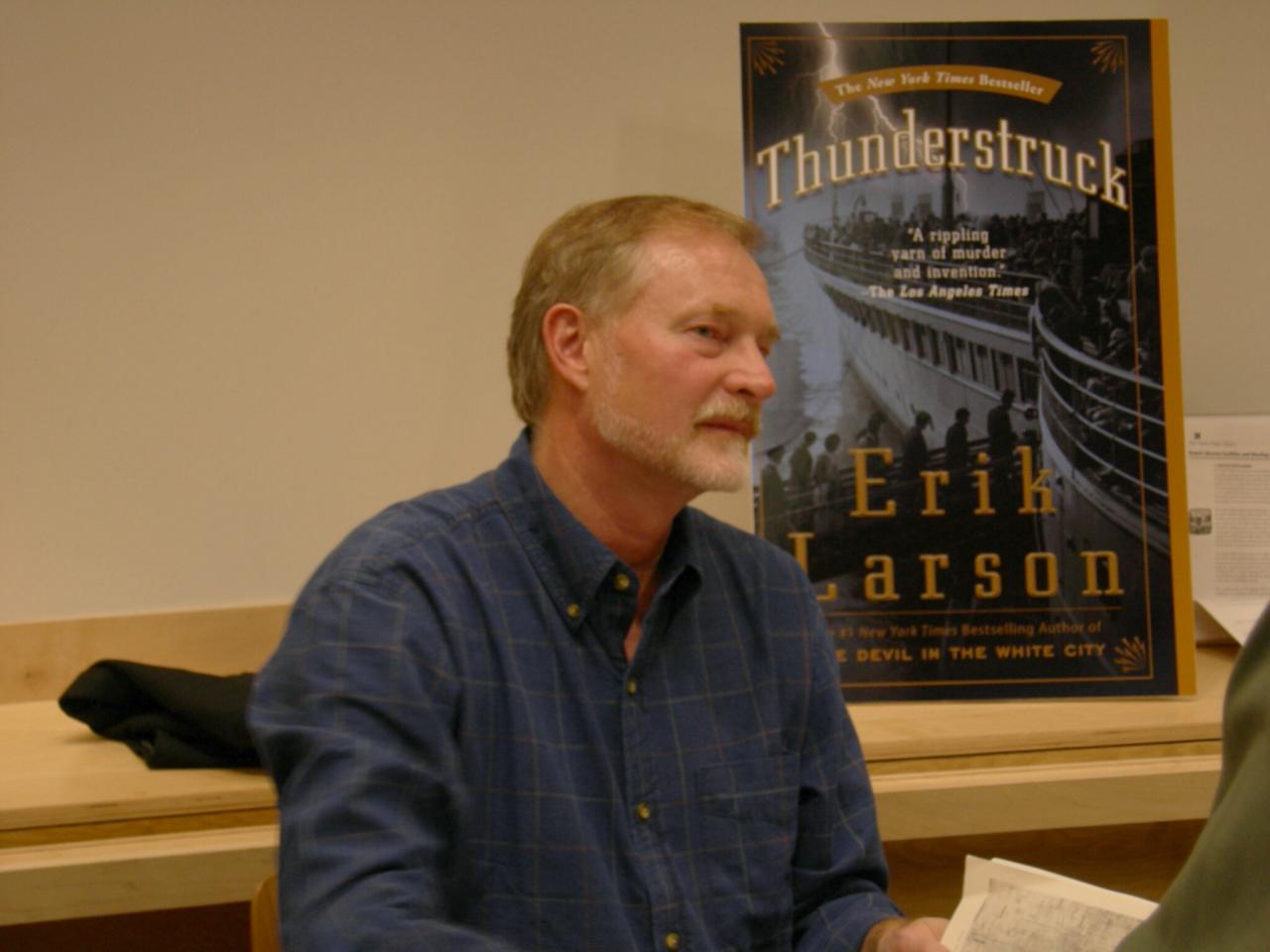
Erik Larson has captivated readers with his masterful blend of historical accuracy and captivating storytelling, redefining the boundaries of narrative nonfiction. From the chilling tale of “The Devil in the White City” to the poignant account of “In the Garden of Beasts,” Larson’s works have illuminated historical events with unparalleled clarity and emotional depth.
Erik Larson’s Notable Works
Erik Larson is an acclaimed author known for his historical non-fiction works that blend meticulous research with captivating storytelling. His books have garnered widespread recognition for their exploration of complex historical events and the human experience within them.Larson’s most celebrated work is “The Devil in the White City” (2003), a dual narrative that intertwines the construction of the 1893 World’s Fair in Chicago with the gruesome crimes of serial killer H.H.
Holmes. The book delves into themes of ambition, corruption, and the duality of human nature.Another notable work is “In the Garden of Beasts” (2011), which chronicles the experiences of William E. Dodd, the first U.S. ambassador to Nazi Germany.
Through Dodd’s perspective, Larson provides an intimate glimpse into the rise of the Nazi regime and the challenges faced by those who opposed it.
Published Works and Genres
Larson’s published works include:
- Isaac’s Storm(1999) – Meteorology
- The Devil in the White City(2003) – Historical Non-Fiction
- Thunderstruck(2006) – Historical Non-Fiction
- In the Garden of Beasts(2011) – Historical Non-Fiction
- Dead Wake(2015) – Historical Non-Fiction
- The Splendid and the Vile(2020) – Historical Non-Fiction
Larson’s works consistently explore themes of human ambition, resilience, and the interplay between individuals and historical events. His writing is characterized by its vivid prose, meticulous research, and ability to transport readers to the heart of the past.
Erik Larson’s Writing Style and Techniques
Erik Larson’s writing style is a distinctive blend of historical accuracy and captivating storytelling. He meticulously researches his subjects, drawing heavily on primary sources to ensure the authenticity of his narratives. His immersive descriptions and character-driven storytelling transport readers into the past, creating a vivid and engaging experience.
Use of Primary Sources
Larson’s commitment to historical accuracy is evident in his extensive use of primary sources. He pores over letters, diaries, newspaper accounts, and other contemporary documents to capture the voices and perspectives of those who lived through the events he describes.
This approach lends an unparalleled authenticity to his narratives, allowing readers to connect directly with the people and events of the past.
Immersive Descriptions
Larson’s writing is known for its immersive descriptions that transport readers to the scenes of his stories. He paints vivid pictures of settings, from bustling city streets to remote wilderness landscapes. His evocative language appeals to all the senses, creating a multi-dimensional experience that draws readers into the narrative.
Character-Driven Narratives
At the heart of Larson’s writing are the characters who inhabit his stories. He develops complex and relatable characters who drive the narrative forward and provide a human connection to the historical events. Larson delves into their motivations, struggles, and triumphs, allowing readers to empathize with their experiences and understand the impact of the past on individual lives.
Erik Larson’s Impact on Historical Literature

Erik Larson’s contributions to the field of historical literature have been significant. Through his captivating narratives, he has not only popularized the genre of narrative nonfiction but also influenced the way historians approach and present historical events.
Influence on Narrative Nonfiction
Larson’s works have demonstrated the power of storytelling in historical writing. By blending historical facts with vivid characters and engaging narratives, he has made history accessible and relatable to a wider audience. His approach has inspired a new generation of historians to adopt a more narrative style, making historical writing more engaging and accessible.
Public Perception of Historical Events
Larson’s books have also shaped the public’s perception of historical events. His focus on the human experience during pivotal moments in history has brought a fresh perspective to familiar events. Through his meticulous research and attention to detail, he has shed light on lesser-known aspects of history, challenging conventional narratives and broadening our understanding of the past.
Erik Larson’s Research and Sources

Erik Larson’s meticulous research process forms the backbone of his captivating historical narratives. He immerses himself in primary and secondary sources, collaborating with historians, archivists, and subject matter experts to ensure accuracy and depth.
Primary Sources
- Larson extensively examines original documents, letters, diaries, and other firsthand accounts to gain a firsthand perspective on historical events.
- By delving into these primary sources, he uncovers nuances and insights that might otherwise remain hidden, adding richness and authenticity to his writing.
Secondary Sources
- Larson supplements his primary source research with scholarly works, biographies, and other secondary sources to provide context and broaden his understanding of the historical era he is writing about.
- He carefully evaluates the credibility and biases of these sources, ensuring that his interpretations are well-informed and balanced.
Collaboration with Experts, Erik larson
- Larson collaborates with historians, archivists, and other experts in the field to gain specialized knowledge and insights.
- These collaborations help him navigate complex historical issues, ensuring that his work is both accurate and engaging.
Erik Larson’s Awards and Recognition

Erik Larson has garnered widespread recognition for his literary achievements, receiving prestigious awards that attest to the excellence of his historical writing.
Among his notable accolades are the:
Pulitzer Prize
- Finalist in 2004 for “The Devil in the White City”
National Book Award
- Winner in 2003 for “The Devil in the White City”
Edgar Award
- Winner in 2004 for “The Devil in the White City”
- Nominee in 2018 for “Dead Wake”
Anisfield-Wolf Book Award
- Winner in 2004 for “The Devil in the White City”
PEN/Jacqueline Bograd Weld Award for Biography
- Winner in 2004 for “The Devil in the White City”
These awards underscore Larson’s ability to captivate readers with his immersive historical narratives, combining meticulous research with engaging storytelling. His recognition not only honors his literary prowess but also acknowledges the significant contribution he has made to the understanding and appreciation of history.
Erik Larson’s Historical Accuracy and Controversies

Erik Larson’s works have been praised for their historical accuracy and narrative engagement. However, his approach to blending historical fidelity with storytelling has also sparked debates and controversies.Larson’s historical accuracy is generally well-regarded. He conducts extensive research, using primary sources and consulting with experts to ensure the factual accuracy of his accounts.
However, some critics have questioned whether his focus on narrative engagement sometimes compromises historical fidelity.
Balancing Historical Fidelity and Narrative Engagement
Larson argues that it is possible to write historically accurate accounts while still engaging readers with a compelling narrative. He believes that historical events are inherently dramatic and that it is his responsibility as a writer to bring that drama to life.However,
some historians argue that Larson’s focus on narrative engagement can lead him to oversimplify or sensationalize historical events. They contend that in his quest to make history more accessible, he may sacrifice some of its complexity and nuance.
Challenges of Writing About Complex Historical Figures
Another challenge Larson faces is writing about complex historical figures. He strives to present these figures in a balanced and nuanced way, acknowledging their strengths and weaknesses. However, some critics have accused him of bias or of downplaying the negative aspects of certain historical figures.Larson’s
approach to historical accuracy and controversies has been influential in the field of historical literature. He has demonstrated that it is possible to write historically accurate accounts that are also engaging and accessible to a wide audience. However, his work has also sparked debates about the balance between historical fidelity and narrative engagement, and the challenges of writing about complex historical figures.
Erik Larson’s Cultural Influence
Erik Larson’s captivating narratives have transcended the literary realm, leaving an enduring imprint on society. His works have sparked a renewed interest in history, inspiring historical tourism and fueling public discourse on significant events.
Influence on Historical Tourism
Larson’s meticulous research and vivid storytelling have made historical sites featured in his books, such as the RMS Titanic and the World’s Columbian Exposition, popular tourist destinations. Visitors seek to immerse themselves in the settings of his narratives, gaining a deeper understanding of the past through the lens of his engaging prose.
Impact on Public Discourse
Larson’s works have sparked thought-provoking discussions about the complexities of history. His nuanced portrayal of historical figures and events has challenged conventional narratives, inviting readers to reconsider their perspectives on the past. His writings have fostered a more nuanced understanding of human motivations and the impact of decisions made in pivotal moments.
Inspiration for Artistic Endeavors
Larson’s evocative storytelling has inspired numerous artistic endeavors, including films, documentaries, and theatrical productions. His novel “The Devil in the White City” was adapted into a television series, while “In the Garden of Beasts” served as the basis for a documentary.
These adaptations have brought Larson’s narratives to a wider audience, further amplifying their cultural impact.
Last Recap
Erik Larson’s contributions to literature and history have earned him widespread acclaim and cemented his legacy as a pioneer in the field of narrative nonfiction. His works continue to inspire, provoke thought, and transport readers to the heart of pivotal historical moments, ensuring his enduring impact on the cultural landscape.
User Queries
What is Erik Larson’s writing style like?
Larson’s writing style is characterized by its seamless integration of historical accuracy with captivating storytelling techniques. He employs primary sources, immersive descriptions, and character-driven narratives to bring historical events to life.
How has Erik Larson influenced historical literature?
Larson’s works have played a pivotal role in popularizing narrative nonfiction and historical writing. His ability to make complex historical subjects accessible and engaging has inspired other authors and shaped the public’s perception of historical events.







Leave a Reply